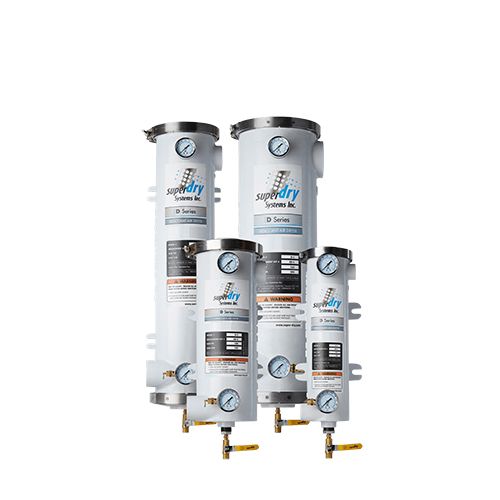The erosion of compressed air systems, product contaminations, and disruptions in manufacturing processes can ultimately result in reduced profits. Therefore, to maintain product quality, reduce maintenance costs, and prevent losses due to downtown, it is essential to have a consistent supply of dry compressed air, which is possible through desiccant air dryers.
Adsorbents are used in regenerative and non-regenerative desiccant dryers to remove moisture from compressed air under pressure. After they are full, the adsorbent is regenerated or replaced. The adsorbent material is prepared for use once it has been regenerated or replaced by fresh desiccant.
Moreover, they supply extremely low dew points and increase energy efficiency. You can use these dryers for a wide range of industrial applications that require dew points as low as -40° F.
There is a wide range of desiccant air dryers for different purposes. This blog post covers the most commonly used ones, so keep reading to learn more.
Common Types of Desiccant Air Dryers
Here are some common types of regenerative or desiccant air dryers you should know about:
1. Pressure Swing Desiccant Air Dryers
The Pressure Swing Desiccant Air Dryer is one of the most basic types of desiccant air dryers. Pressure swing dryers consist of many vessels in which the pressure alternates, allowing the remaining vessels to regenerate their adsorbent while one vessel is utilized to dry the air.
The containers are exchanged in the dryers after a few five to ten-minute cycles. In the regeneration phase, the moisture is desorbed using heat adsorbed.
2. High-Pressure Swing Desiccant Air Dryers
High-Pressure Swing Desiccant Air Dryers can discharge the adsorption heat at higher pressures due to air density, which prolongs the drying process. There is no heat retention in these types of dryers, allowing them to be used in the regeneration process. Moreover, these dryers generally have cycle times of 30 to 60 minutes.
The desiccant bed is regenerated using unheated purge air, and the exhaust temperatures can be up to 100°F below the input temperatures.
3. Heated Desiccant Air Dryers
Heated Desiccant Air Dryers heat the desiccant and blow air across it for drying. Therefore, extra moisture is held in the heated air, which also aids in cooking off part of the liquid water. It consumes less power since it uses less purge air by heating the air. While they cost roughly 50% more, the payback period is often shorter than two years.
A heated desiccant dryer’s discharge temperature ranges from 350 to 450 degrees Fahrenheit. This dryer typically comes with specialist high-temp filters, but you must consider the heat.
The pipeline and dryer both need to be insulated. Also, remember that temperature affects the pressure ratings of the pipe and fittings. Moreover, heat can damage downstream sensitive equipment.
4. Heatless Twin-Tower Desiccant Air Dryers
The Heatless Twin-Tower Desiccant Air Dryers are commonly used for industrial applications. They have a lower initial cost, but they aren’t very cost-effective because they use more electricity. This type of drier regenerates its desiccant by purging the air.
Towers come in two varieties: one for regenerating and the other for drying. Compressed air is flowing out of and through the regenerating tower. In other words, you need a big leak to replenish the desiccant.
5. Internally Heated Desiccant Air Dryers
With this type of drier, heaters are either routed through desiccant beds or attached to desiccant vessels’ shells. Typically, these dryers run in four-hour cycles.
Moreover, internally heated dryers only have one drawback: the desiccant must be replaced regularly due to the hydro-thermal degradation of the absorbent at high temperatures in damp settings.
6. Combination Desiccant or Refrigerated Air Dryers
Combination Desiccant or Refrigerated Air Dryers are positioned before heated blower purge dryers. This placement is because using power to create the purge air from a desiccant drier is more expensive than using a refrigerator to cool a dryer.
The ideal situation for this type of dryer is when temperatures drop below 40 degrees F, but your process only requires a dew point of 40F or above. The dryer will therefore operate when it’s hot, and the desiccant won’t start working until it’s cold.
This dryer is incredibly energy-efficient, even at a lower dew point. This system uses less power to operate, but it lasts longer because the desiccant is exposed to less moisture. Regular maintenance can increase the dryer’s life from 5 to 10 years while reducing maintenance costs.
7. Single Tower Non-Regenerative Blower Purge Desiccant Air Dryers
Single Tower Blower Purge Desiccant Air Dryers have a large desiccant tower, which is big enough to maintain the compressor’s rated flow for between 16 to 20 hours. It regenerates the desiccant at the end of the cycle by heating it and using a tiny side channel blower. Normally, it takes 4 to 8 hours to regenerate completely.
This type of desiccant air dryer is extremely sturdy, efficient, and easy to maintain. However, one drawback is you can’t use it around the clock without doubling up.
8. Single Tower Filter Desiccant Dryer
Air compressor filter dryers eliminate contaminants and water from compressed air at the point of use. You must install them before the air tools and after the air task for them to function effectively. These dryers ensure the air is dry and clean, ultimately preventing moisture damage to equipment and machinery. They are non-regenerative, meaning that the desiccant cartridge must be changed when saturated.
Final Word
If you are searching for a desiccant air dryer for point-of-use, look no further than Super Dry Systems. We offer a range of affordable desiccant air dryers, including Inline Desiccant Dryers for Air Compressors, Mini Air Compressor Filter Dryers, Air Compressor Water Separator, Compressed Air Dryer Filters, and more.
You can contact us by visiting our website. You can also email info@super-dry.com or call 1-888-828-1122 to learn more about our services.


